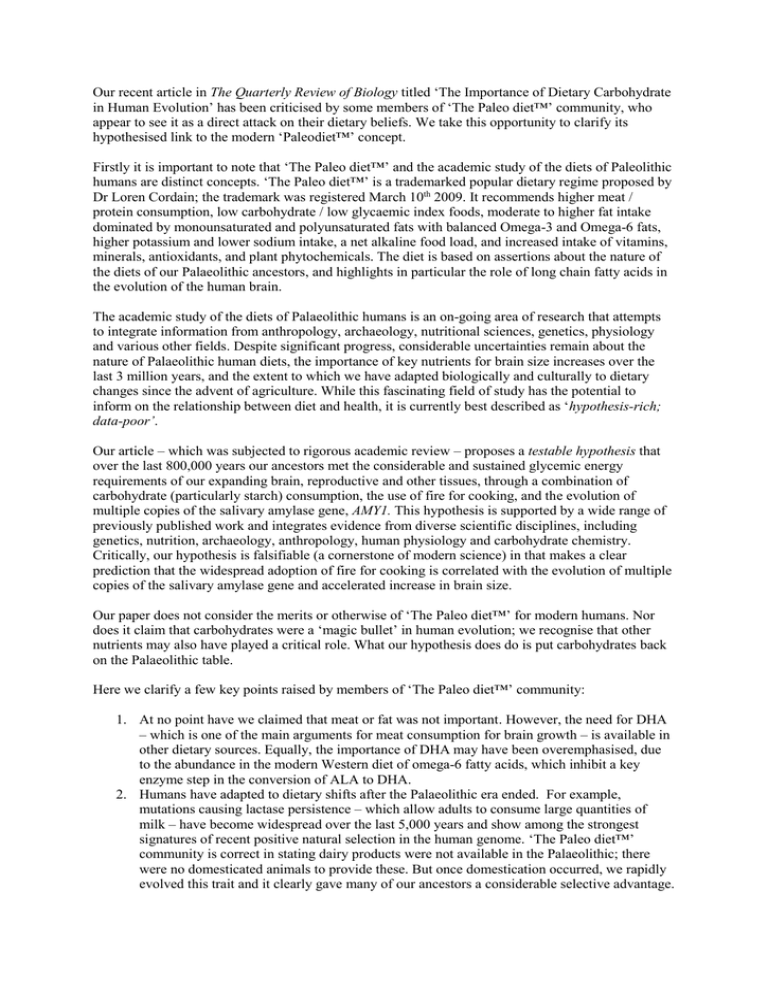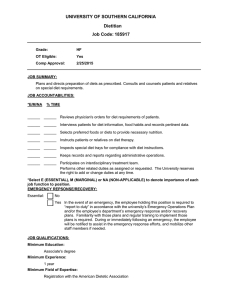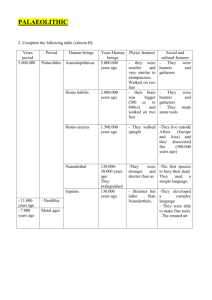The Quarterly Review of Biology
advertisement

Our recent article in The Quarterly Review of Biology titled ‘The Importance of Dietary Carbohydrate in Human Evolution’ has been criticised by some members of ‘The Paleo diet™’ community, who appear to see it as a direct attack on their dietary beliefs. We take this opportunity to clarify its hypothesised link to the modern ‘Paleodiet™’ concept. Firstly it is important to note that ‘The Paleo diet™’ and the academic study of the diets of Paleolithic humans are distinct concepts. ‘The Paleo diet™’ is a trademarked popular dietary regime proposed by Dr Loren Cordain; the trademark was registered March 10th 2009. It recommends higher meat / protein consumption, low carbohydrate / low glycaemic index foods, moderate to higher fat intake dominated by monounsaturated and polyunsaturated fats with balanced Omega-3 and Omega-6 fats, higher potassium and lower sodium intake, a net alkaline food load, and increased intake of vitamins, minerals, antioxidants, and plant phytochemicals. The diet is based on assertions about the nature of the diets of our Palaeolithic ancestors, and highlights in particular the role of long chain fatty acids in the evolution of the human brain. The academic study of the diets of Palaeolithic humans is an on-going area of research that attempts to integrate information from anthropology, archaeology, nutritional sciences, genetics, physiology and various other fields. Despite significant progress, considerable uncertainties remain about the nature of Palaeolithic human diets, the importance of key nutrients for brain size increases over the last 3 million years, and the extent to which we have adapted biologically and culturally to dietary changes since the advent of agriculture. While this fascinating field of study has the potential to inform on the relationship between diet and health, it is currently best described as ‘hypothesis-rich; data-poor’. Our article – which was subjected to rigorous academic review – proposes a testable hypothesis that over the last 800,000 years our ancestors met the considerable and sustained glycemic energy requirements of our expanding brain, reproductive and other tissues, through a combination of carbohydrate (particularly starch) consumption, the use of fire for cooking, and the evolution of multiple copies of the salivary amylase gene, AMY1. This hypothesis is supported by a wide range of previously published work and integrates evidence from diverse scientific disciplines, including genetics, nutrition, archaeology, anthropology, human physiology and carbohydrate chemistry. Critically, our hypothesis is falsifiable (a cornerstone of modern science) in that makes a clear prediction that the widespread adoption of fire for cooking is correlated with the evolution of multiple copies of the salivary amylase gene and accelerated increase in brain size. Our paper does not consider the merits or otherwise of ‘The Paleo diet™’ for modern humans. Nor does it claim that carbohydrates were a ‘magic bullet’ in human evolution; we recognise that other nutrients may also have played a critical role. What our hypothesis does do is put carbohydrates back on the Palaeolithic table. Here we clarify a few key points raised by members of ‘The Paleo diet™’ community: 1. At no point have we claimed that meat or fat was not important. However, the need for DHA – which is one of the main arguments for meat consumption for brain growth – is available in other dietary sources. Equally, the importance of DHA may have been overemphasised, due to the abundance in the modern Western diet of omega-6 fatty acids, which inhibit a key enzyme step in the conversion of ALA to DHA. 2. Humans have adapted to dietary shifts after the Palaeolithic era ended. For example, mutations causing lactase persistence – which allow adults to consume large quantities of milk – have become widespread over the last 5,000 years and show among the strongest signatures of recent positive natural selection in the human genome. ‘The Paleo diet™’ community is correct in stating dairy products were not available in the Palaeolithic; there were no domesticated animals to provide these. But once domestication occurred, we rapidly evolved this trait and it clearly gave many of our ancestors a considerable selective advantage. 3. Hunting wild animals is far less secure than collecting plants from a known source. Without the behavioural ability to exploit plants for nutritional purposes hominins would have had insecure and dangerously randomised access to their essential daily nutrition, which would be based entirely on their ability to hunt. 4. Evidence for fish and shellfish, an important component of ‘The Paleo diet™’, occurs in a small number of sites in South Africa and the Mediterranean during the Middle Palaeolithic. However, there is little evidence for the widespread integration of marine products into the human diet until the Mesolithic, a short period after the end of the Palaeolithic. ‘The Paleo diet™’ is an artificial construct that has limited demonstrable overlap with what we can confidently state our Palaeolithic ancestors ate. The Palaeolithic period lasted for at least 2.6 million years, incorporated several species of ancestral hominins, including modern humans, and covered a wide-range of environments and ecologies; from equatorial rain forests to Arctic tundra. There is no single ‘Palaeolithic diet’. Knowledge of actual Palaeolithic diets does have the potential to increase our understanding of the relationship between diet and health today, and as we state in our paper, “to a first order of approximation – our physiology should be optimized to the diet that we have experienced during our evolutionary past.” But Palaeolithic diets are still very poorly characterised as so little evidence survives from most of this extremely long time period. In the absence of robust quantitative evidence it is perhaps tempting for some to assert as fait accompli that we ate a specific diet during the Palaeolithic era, particularly when a profit motive is involved. Meanwhile, the scientific community is slowly and cautiously building up a clearer picture of ancestral diets, and we hope our paper makes a meaningful contribution to that endeavour. Karen Hardy Jennie Brand-Miller Katherine D. Brown Mark G. Thomas Les Copeland




